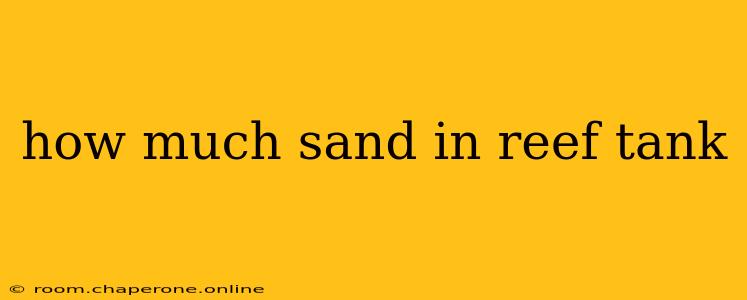Choosing the right amount of sand for your reef tank is crucial for a thriving ecosystem. Too little, and you risk instability; too much, and you'll face cleaning challenges and potential nutrient issues. This guide delves into determining the perfect sand bed depth for your specific reef aquarium setup.
Understanding the Role of Sand in a Reef Tank
Sand in a reef tank isn't just aesthetically pleasing; it plays a vital role in the overall health and stability of your aquatic ecosystem. A deep sand bed (DSB) acts as a natural filter, fostering beneficial bacteria crucial for nutrient processing. This biological filtration helps maintain water quality, reducing the workload on your mechanical filtration system. The sand also provides a habitat for various organisms, enriching the biodiversity within your tank.
Factors Affecting Sand Depth
Several factors influence the ideal sand depth for your reef tank. These include:
1. Tank Size and Dimensions:
Larger tanks generally accommodate deeper sand beds. A larger volume allows for a more stable environment and better nutrient processing. Smaller tanks might benefit from shallower beds to minimize cleaning challenges.
2. Type of Reef Tank:
The type of reef tank (e.g., nano reef, large reef system) significantly impacts sand depth. Nano reefs often utilize shallower beds, while larger systems can support deeper ones. Consider the scale of your setup and its overall bioload.
3. Filtration System:
Your filtration system's capacity influences the necessary sand depth. A robust filtration system can manage a deeper bed more effectively, while a less powerful system might benefit from a shallower bed to avoid nutrient buildup.
4. Personal Preferences and Design:
The aesthetic appeal of your reef tank also plays a role. A deeper sand bed might be preferred for creating a more natural-looking environment, while a shallower bed might suit a minimalist design.
Recommended Sand Depths
There's no one-size-fits-all answer to the question of sand depth. However, here's a general guideline:
-
Shallow Sand Bed (SSB): 1-2 inches. Suitable for smaller tanks, simpler systems, and those prioritizing ease of cleaning.
-
Deep Sand Bed (DSB): 4-6 inches or more. Beneficial for larger tanks, supporting robust biological filtration and a more natural environment. Requires careful management to prevent anaerobic conditions.
Important Note: Excessively deep sand beds (over 6 inches) can create anaerobic zones, leading to the release of harmful gases and nutrient imbalances. Careful monitoring and regular maintenance are essential with deeper beds.
Choosing the Right Sand
The type of sand you use also matters. Aragonite sand is a popular choice due to its buffering capacity, helping maintain stable pH levels. Ensure the sand is reef-safe and free of contaminants. Avoid using play sand or other types not specifically designed for aquariums.
Maintaining Your Sand Bed
Regardless of the depth you choose, regular maintenance is key to a healthy sand bed. This includes:
-
Regular water changes: This helps maintain water quality and prevents nutrient buildup.
-
Careful cleaning: Avoid excessive stirring or vacuuming, which can disrupt the beneficial bacteria colonies. Gentle siphoning of surface debris is usually sufficient.
-
Monitoring water parameters: Regular testing of parameters such as nitrates, nitrites, and pH is crucial to ensure a healthy environment.
By carefully considering these factors and following proper maintenance practices, you can ensure your reef tank's sand bed contributes positively to a thriving and beautiful aquatic environment. Remember, research is crucial; consult with experienced reef keepers and do thorough research before setting up your reef tank.

